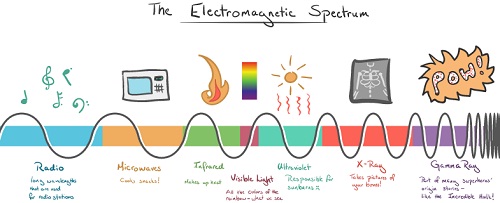It is divided into seven major regions or bands. A band consists of a range of frequencies in the spectrum in terms of frequencies i.e. radio, microwaves, infra-red.
Properties of electromagnetic waves
Common properties
- They do not require a material medium and can travel through a vacuum.
- They undergo reflection, refraction and diffraction.
- All electromagnetic waves travel at the speed of light i.e. 3 * 108 ms-1.
- They carry no electric charge
- They transfer energy from a source to a receiver in the form of oscillating electric and magnetic.
Examples
1. A VHF radio transmitter broadcasts radio waves at a frequency of 30 M Hz. What is
their wavelength?
Solution
v = f ? => then ? = v / f = 3.0 * 108/ 300 * 106
= 1.00 m.
2. Calculate the frequency of a radio wave of wavelength 150 m.
Solution
v = f ? =>f = v / ? = 2.0 * 106
= 2 M Hz.

